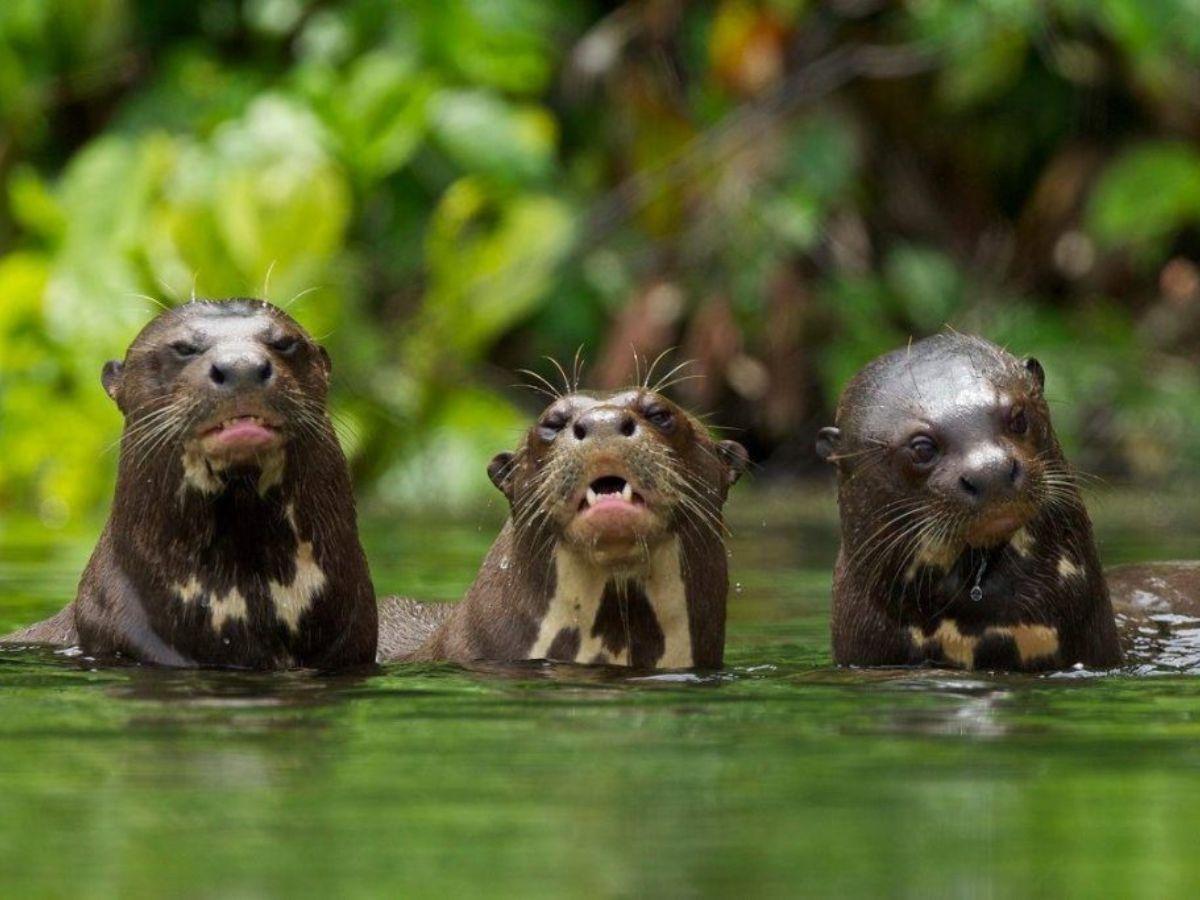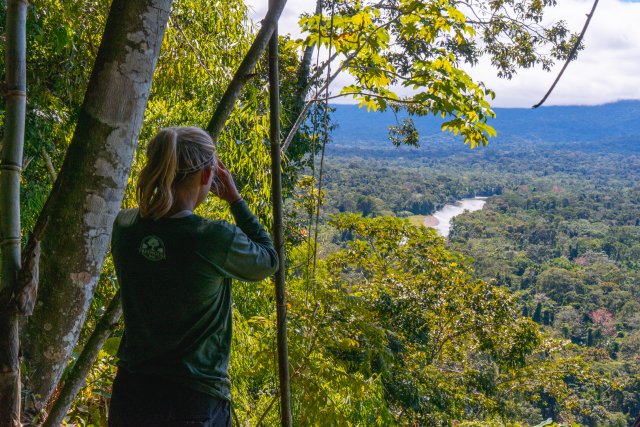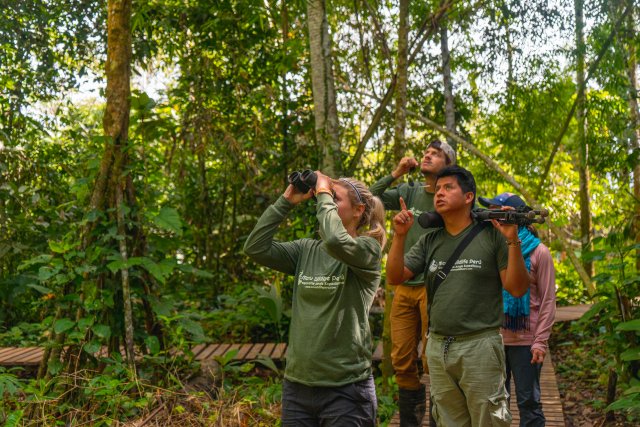The Ultimate Guide For Visiting The Tambopata Jungle In Peru

Why Visit The Chuncho Macaw Clay Lick
April 2, 2024
Is It Worth Visiting Sandoval Lake?
April 9, 2024One of the most biodiverse areas on the planet, the Tambopata Jungle in Peru is an outstanding natural spectacle to visit.
Home to over 1000 species of animals and over 1700 species of plants, you are guaranteed to experience a rich variety of wildlife when hiking through the rainforest.
In this comprehensive ultimate guide, we’ll cover everything you need to know about the Tambopata Jungle in Peru. This includes why you should visit, how to get there, booking the best jungle lodges, staying safe and much more.
Why Visit The Tambopata Jungle?
This diverse area of the Amazon Rainforest has many incredible things to both see and do, whether that be spotting exotic animals or zip-lining through the jungle canopy. Here we’ll go through some of the very best reasons to visit the Tambopata Jungle.
See Wild Animals Native To The Region
As previously mentioned, the Tambopata Jungle is home to over 1000 species of animals. Many of these are common sightings along our tours, such as Capybara, Macaws, Capuchin Monkeys and Caiman.
There are particular areas where many of these animals thrive within, which make a sighting of them almost guaranteed every day. For example, within the Macaw Clay Lick (Collpa Chuncho) there are an abundance of Parrots, Macaws and Parakeets that visit this region daily to feed on the nutrient-rich clay licks.
It’s also similar with Tapir, who often congregate around their own clay lick. When visiting this particular spot, there’s also a good chance of seeing Howler Monkeys, Peccaries, Deer and Woodpeckers along the way.

Enjoy A More Unique And Remote Part Of The Amazon Jungle
Overall the Amazon Jungle is a massive area that encompasses a large swathe of the South American continent. Home to over 53 ecosystems, it covers areas not just of Peru and Brazil, but also Ecuador, Colombia, Venezuela, Bolivia, Guyana and Suriname.
Throughout we will find many popular areas to visit the Amazon, including Iquitos (Peru) and Manaus (Brazil). However, the Tambopata Jungle offers travelers a much more rugged and raw experience of the rainforest, where you can enjoy trails and tours with much less tourists around.
Not only does this make both the night walks and daytime Jungle hikes more memorable, it also means there’s a much greater chance of seeing rarer wildlife when heading away from Puerto Maldonado. This includes Green Anaconda, Jaguars and Poison Dart Frogs, which leads well into our next point…
Potentially Spot Rarer Amazonian Species
Whilst many animals are common to see on most jungle tours (such as Capybara and Monkeys), there is also a chance of seeing some of the more rare and elusive species too.
The Jaguar is one of the most formidable predators of the Amazon Jungle, which can be found throughout this massive rainforest. Tambopata is known to be the best place in South America to spot these, given the higher concentration of this species within this region. Of course it will still be difficult and we’ll need some luck, however many of our past clients have spotted these before on our tours!
Another harder to spot animal here is the Green Anaconda, which thrives within the water and muddier plains of the Tambopata Jungle. Usually you’ll need to go on a specialized tour to find an Anaconda, given they lurk in harder-to-reach areas.
It’s important to mention that none of these animals (or any of the usual sightings) are 100% guaranteed every time. This is because the animals here are wild and unpredictable, although our expert guides have studied these animals well and know where it is best to find them.

Enjoy Various Adrenaline-fuelled Activities
From Puerto Maldonado it’s also possible to enjoy various other activities. These are best for those who have less time to explore deeper parts of the jungle, or for those who fancy changing things up between tours whilst waiting in the city.
One of these is walking along the suspended canopy bridges, where you’ll be over 30ft above the ground and be able to see out and over the surrounding rainforest. It’s also possible to go zip-lining too, where you’ll race through the jungle and get quite the rush of adrenaline!
Heading on boat tours along the Amazon River is also quite an enthralling experience in itself. During the day we can head to Sandoval Lake which is home to Giant River Otters, whilst at night we can go on an eerie search of Black Caiman which lurk beneath the waters.
How To Get To The Tambopata Jungle
Once you’ve decided you want to visit Tambopata, the next step in planning your trip is working out how to get here. Here we’ll discuss your main options.
Arriving Into Puerto Maldonado
No matter where you are coming from, you’ll first need to head to the city of Puerto Maldonado within the Madre de Dios region.
There are daily flights from Lima here, which usually cost between $70-90 (without baggage) and take just under two hours to arrive. You can also fly from Cusco for a similar price, which takes just an hour to get from the Andes to the Amazon Rainforest. Standard airlines like LATAM usually have daily flights to Puerto Maldonado from both Lima and Cusco.
Those who are already in Cusco can also choose to take the bus. Operators like Palomino, Maldonado Tours and Grupo Iberia offer multiple departures throughout the day, with the ride taking between 10-12 hours. The price of a one-way bus ticket usually costs between $15-30 (with the more expensive ones being luxury companies that include food and more comfortable seats).
Lastly, you can also take the bus here from neighboring Brazil. The city of Rio Branco is the closest major city to the Peruvian border, with the bus taking anywhere between 12-15 hours (factoring in potential delays at the immigration border control). A one-way bus ticket costs around $70.
Getting From Puerto Maldonado To The Tambopata Jungle
Having arrived into Puerto Maldonado, you’ll now be in the perfect basecamp for exploring the Tambopata Jungle.
It’s highly recommended to go with a local operator, given it’s unsafe and impractical to try going independently. You can find local fishermen down by the docks who can take you out, however you’ll need a good grasp of Spanish to communicate and also be prepared to pay more for a private ride.
The other way is to head on an organized jungle tour, which combines safety, practicality and comfort all together. Here at Collpa Chuncho we offer a variety of different jungle tours where you can see the very best highlights of the Tambopata Jungle.
This includes heading on a multi-day tour of Sandoval Lake and Collpa Chuncho, where you can head even deeper into this remote part of the Peruvian rainforest.
When Is The Best Time To Visit The Tambopata Jungle?
Whilst the Tambopata Jungle remains pretty hot most of the year, there are different periods which can affect your experience.
First of all we have the dry season, which begins in April and lasts until September. Characterized by less rains (between 1.5-5 inches falling throughout each of these months), this time of year is best for seeing wildlife. This includes Giant River Otters and Capybara, as well as many other land-based mammals that head out onto the enlarged river banks in search of food.
The wet season runs from October until March, and of course has much more rain and stormier weather. We can expect anywhere from 6-11.5 inches within each month, which of course makes it highly likely you’ll have some downpours during your expedition. However the main trade-off is that there are much less other tourists around, so you can enjoy a much more authentic experience. As well as this, the extra rain coincides with the fruit-bearing seasons (such as for the Chestnut tree), so you will also see a more vivid and bright jungle.
There’s also another period worth noting, which is between the months of May until September. During these months a unique phenomenon happens, where cool winds are carried up to the Tambopata Jungle from Argentina. This can lead to temperatures dropping substantially, so it’s important to bring warm clothing if heading during this time. It’s important to note that this happens sporadically between these months, and may not happen during your visit (and if it does, it usually lasts a maximum of a few days at a time).
You can read more about when is the best time to visit the Tambopata Jungle.

Staying Safe In The Tambopata Jungle
It’s very important to remember that this area of the jungle is wild and untamed. Whilst this certainly makes for an incredible experience, it does mean that you also have to take safety measures seriously.
Some precautions can be taken before you have even arrived into Puerto Maldonado. Getting your Yellow Fever vaccination is recommended since mosquitoes that carry this disease can be present in this region. It’s also a good idea to buy a high DEET mosquito spray in order to keep them at bay during your jungle treks. Whilst buying this, it’s also important to get yourself some high factor sunscreen since the sun here can be very intense.
Once you arrive into the Tambopata Jungle with your organized tour, you’ll want to follow all of the advice that your group leader tells you. Most are common sense, such as not getting close to wild animals or swimming in the river without the permission of your guide. Remember that a lot of these animals (such as Crocodiles and Snakes) can be potentially lethal, so all advice and rules are in place for your safety.
It’s also advisable to wear adequate clothing for treks through the jungle, such as long pants and sturdy hiking boots. We’ll explore more of this later when discussing how to best prepare for an expedition into the Tambopata Jungle.
Choosing The Best Jungle Lodges In The Tambopata Jungle
There are quite a range of jungle lodges to choose from in Tambopata, all of which can vary in terms of style (luxury or basic), remoteness, proximity to key sites and of course price.
The Best All-Rounder Lodge: Collpa Chuncho
If you want a mix of the factors above without spending so much, then our comfortable Jungle lodges will be the perfect choice for you. Situated close to the Chuncho Macaw Clay Lick, you’ll be able to see many birds and wild animals close to where you are staying. The price of the Collpa Chuncho Suite is included in our tours.
The Best Luxury Lodge: Inkaterra Reserva Amazonica
Staying right on the Madre de Dios river, these beautiful cabins are located within a private ecological reserve. This makes it easy to see various animals without heading so far, and has all the amenities you’d ever need when enjoying this area of the Peruvian Amazon Jungle. Prices start at $275 a night for these more luxurious cabins.
The Best Lodge For Animal Sightings: Tambopata Research Centre
With the highest density of animals in the surrounding areas, this jungle lodge is perfect for those who want animals in close proximity to their site. Although it’s located far (over 8 hours from Puerto Maldonado) and costs $550+ a night, it’s one of the best places to spot a Jaguar in the region with sightings common among guests.
How To Book The Right Tambopata Jungle Tour For You
Although the Tambopata Jungle remains less touristy than the Amazon Jungle in Iquitos, there are still a variety of tours here that can offer really different experiences. That’s why it’s important to browse well before selecting a tour, and seeing what distinct advantages each specific company and tour offers.
At Collpa Chuncho, our tours offer both a cultural experience as well as a focus on seeing exotic wildlife. Our tour guides were born and raised in the jungle, and as such are experts when it comes to finding rare animals and teaching us about endemic plant species.
4 Day Tour To Collpa Chuncho And Sandoval Lake
Those who are looking for the overall best experience will love this 4 Day Tour to Collpa Chuncho and Sandoval Lake. Two of the most sought-after destinations in Tambopata, here we will have plenty of time to observe Macaws, Giant River Otters and a whole host of other animals (such as Monkeys, Crocodiles and Capybara).
As well as including your stay at the Collpa Chuncho Suites, you will have all meals, transportation and specific tours included (such as night walks and a visit to the Tapir Clay Lick).
Chuncho Macaw Clay Lick 2 Day Tour
If you have less time available but still want to see colorful Macaws in Collpa Chuncho, then the Chuncho Macaw Clay Lick 2 Day Tour is your best option. Here you will spend a night at our comfortable Jungle lodge, which includes all transport and meals for the two days.
You will spend the day observing the Chuncho Macaw Clay Lick with our expert guides, who will also take you on a walk to see other native species. At night you will head on a Caiman-spotting boat tour – a classic experience which you simply must have when visiting Tambopata!
How To Prepare For An Expedition Into The Tambopata Jungle
Preparation really is key for both a memorable and smooth experience within the Tambopata Jungle.
It’s important to know what kind of environment you are entering, including everything you will see, the activities you will do as well as any risks to be aware of (which this guide and many other articles we have written cover). Throughout this guide you will find various sections on how to best prepare, such as wearing adequate clothing, bringing powerful mosquito repellent as well as listening to your guide’s advice.
Of course preparing yourself physically and what you will bring is important, but it’s also just as vital to prepare yourself mentally too. Here you will enter a truly magical place, brimming with rare animal species found nowhere else on the planet. For this reason you’ll want to minimize any stress or extra work that you need to do during your trip, and instead come with an open mind to see and try new things. You won’t regret it!
If you are still unsure or have further questions, you can also get in touch with our team of experts who have spent years both studying and leading treks throughout the Tambopata Jungle. Not only do we know where it is best to see certain animals, we also offer guidance on how to best prepare and what kind of equipment you will need.
Our Top Tambopata Jungle Tips
Having operated various types of tours throughout the Tambopata Jungle, we will now share some of our very best tips so you can have the best experience possible here.
Lower Your Specific Expectations
Keeping an open mind when you visit any new destination is important, however is even more so when visiting the wild Amazon Jungle. It’s quite common that travelers are fixated on seeing one specific animal, however nothing can ever be guaranteed since these are wild animals living their own day to day lives.
Of course our expert guides know how to give us the very best chance on our tours, however we’ve found that those who keep an open mind about what they will see will end up having a much more fulfilling experience.
Invest In High Quality Clothing And Equipment
As we’ve mentioned before, choosing to prepare well before your Tambopata Jungle trek can either make or break your experience. For example if you bring high quality hiking trousers, then you will avoid getting bitten by mosquitoes, getting your socks overly wet and also potentially being attacked by a snake or tarantula.
Other clothing includes light breathable tops, a poncho as well as some sturdy hiking boots. It’s also important to buy adequate sunscreen and mosquito spray too, since these will keep you safe and healthy whilst exploring the rainforest.
Embrace The Cultures And Ways Of The Amazon Rainforest
Visiting the Tambopata Jungle is not just a wildlife sightseeing experience – it’s also a cultural one too. Here we can learn more about the tribes who call the rainforest their home, and also have the opportunity to try dishes from the region.
On your tours you can also learn more about how certain medicinal plants are used by locals, as well as other techniques which keep them living in a sustainable way here.
The Ultimate Guide For Visiting The Tambopata Jungle In Peru
And that’s all for this ultimate guide on the Tambopata Jungle in Peru.
Known for its incredibly high levels of diversity, this region of the Amazon Jungle is full of impressive wildlife and natural spectacles.
It’s essential to prepare properly before visiting the Tambopata Jungle, and in this comprehensive guide we have listed everything you need to know. This includes the best time to visit, how to select the best Jungle tour as well as how to keep yourself safe.
We recommend revisiting this article whenever you need for extra guidance, and also to get in touch with us now to book your own dream Tambopata Jungle Tour.



